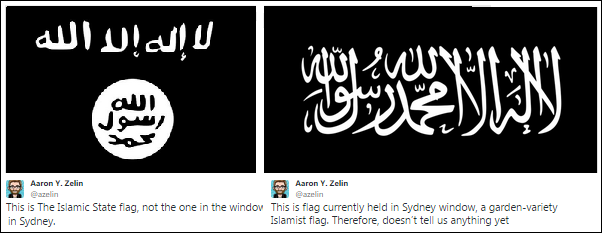Black Banners in Sydney 2: on flags and their meanings
[ by Charles Cameron — the history and dwindling significance of a sign ]
.
**
In my previous post in this series, Black Banners in Sydney 1: a DoubleQuote in the Wild from Ardeet, I wrote:
The flag in the image from the Lindt cafe is not in fact the Daesh / Islamic State flag, and indeed the hostage-taker appears to have asked for a genuine Daesh / IS flag as one of his demands. The flag shown is a black flag containing the Shahada or Islamic profession of faith in white, and black flags in Islam have a history as war flags dating back to the time of the Prophet himself.
The banners are black, and there are implications.
**
First, the black banner was the Prophet’s flag, the raya.
The Islamic Imagery Project at West Point’s Combating Terrorism Center lists “Black Flag” under the heading “Warfare Motifs“, saying:
The Black Flag (al-raya) traces its roots to the very beginning of Islam. It was the battle (jihad) flag of the Prophet Muhammad, carried into battle by many of his companions, including his nephew ‘Ali ibn Abi Talib. The flag regained prominence in the 8th century with its use by the leader of the Abbasid revolution, Abu Muslim, who led a revolt against the Umayyad clan and its Caliphate. The Umayyads, the ruling establishment of the Islamic world at the time, were seen as greedy, gluttonous, and religiously wayward leaders. The Abbasid revolution, then, was aimed at installing a new, more properly Islamic ruling house that would keep orthodox Islam at the center of its regime. Since then, the image of the black flag has been used as a symbol of religious revolt and battle (i.e. jihad). In Shiite belief, the black flag also evokes expectations about the afterlife. In the contemporary Islamist movement, the black flag is used to symbolize both offensive jihad and the proponents of reestablishing the Islamic Caliphate.
The Abbasids flew black banners, and were therefore known as the musawwids, or “wearers of the black”.
**
There are ahadith, considered by the scholar David Cook and others to be Abbasid forgeries, which claim that black banners from the east are a sign of the Mahdi’s coming. One such hadith reads:
If you see the black flags coming from Khurasan, join that army, even if you have to crawl over ice, for this is the army of the Caliph, the Mahdi and no one can stop that army until it reaches Jerusalem.
In Understanding Jihad, Cook writes:
Since Afghanistan, as Khurasan, has powerful resonance with many Muslims because of the messianic expectations focused on that region, this gave the globalist radical Muslims associated with al-Qa’ida under the leadership of Bin Ladin additional moral authority to proclaim jihad and call for the purification of the present Muslim governments and elites.
And as I have said before, Cook notes in his Contemporary Muslim Apocalyptic Literature that bin Laden’s mentor, Abdullah Azzam, made fresh use of this line of messianic tradition and “popularized the position of Afghanistan as the messianic precursor to the future liberation of Palestine” in his book, From Kabul to Jerusalem, while bin Laden refers to finding “a safe base in Khurasan, high in the peaks of the Hindu Kush” in his 1996 Declaration of Jihad.
**
There are many variants on the black flag, some of them carrying the Shahada or proclamation of faith, some decorated with the Prophet’s seal, some identifying particular jihadist factions. And while AQ in particular has capitalized on the hadith for recruitment as Ali Soufan detailed in his book The Black Banners, the breakaway “caliphate” use of black banners has been so prominently reported in the media that what used to be termed “the Al-Qaida flag” is now often called “the ISIS” (or “Islamic State”) flag.
It is against that somewhat confused background that we must understand Man Haron Monis’ demand, once he realized that the black flag with Shahada he was forcing hostages to hold in the window of the Lindt café was not the “right” black flag, that he be brought an “Islamic State” black flag – presumably the one with the Prophet’s seal, which had in fact been known as the “Al-Qaeda flag” before Daesh / IS took it up.
I once asked the American jihadist Omar Hammami, late of Al-Shabaab – who used that same black flag with Shahada and Prophetic seal in Somalia – whether their choice of flag referred only to Muhammad’s banner, or to the “black banners of Khorasan” ahadith also? – to which he replied:
the raayah is something general in religion regardless of color, but obviously those hadiths influenced black choice
**
I have been harping on the “end times” and specifically Mahdist significance of black banners in the contemporary context for seven years now, and lamenting that so little mention is made of the black banners’ apocalyptic connotations.
For the Islamic State / Daesh, there is no need to question its apocalyptic significance – all five issues to date of their magazine Dabiq have focused on the great “end times” battle to be fought at Dabiq in Syria – a name to compare with Har Megiddo, where the battle of Armageddon will be fought in the equivalent Christian “end times” narrative.
But for some demented guy taking hostages in a café in Sydney?
**
It now appears to me that the “meme” of black flags simply meaning “jihadist” is now so wide-spread, that the apocalyptic resonances may no longer be intended when someone picks up such a flag – or photographs it in some new context —
— no more so than the sign of a Che Guevara poster in a college dorm betokens a serious adherent to Marxist revolution.




December 23rd, 2014 at 5:48 am
December 24th, 2014 at 4:22 am
Hi Zen:
.
I’ve fixed your image so it posts.
December 24th, 2014 at 4:19 pm
🙂